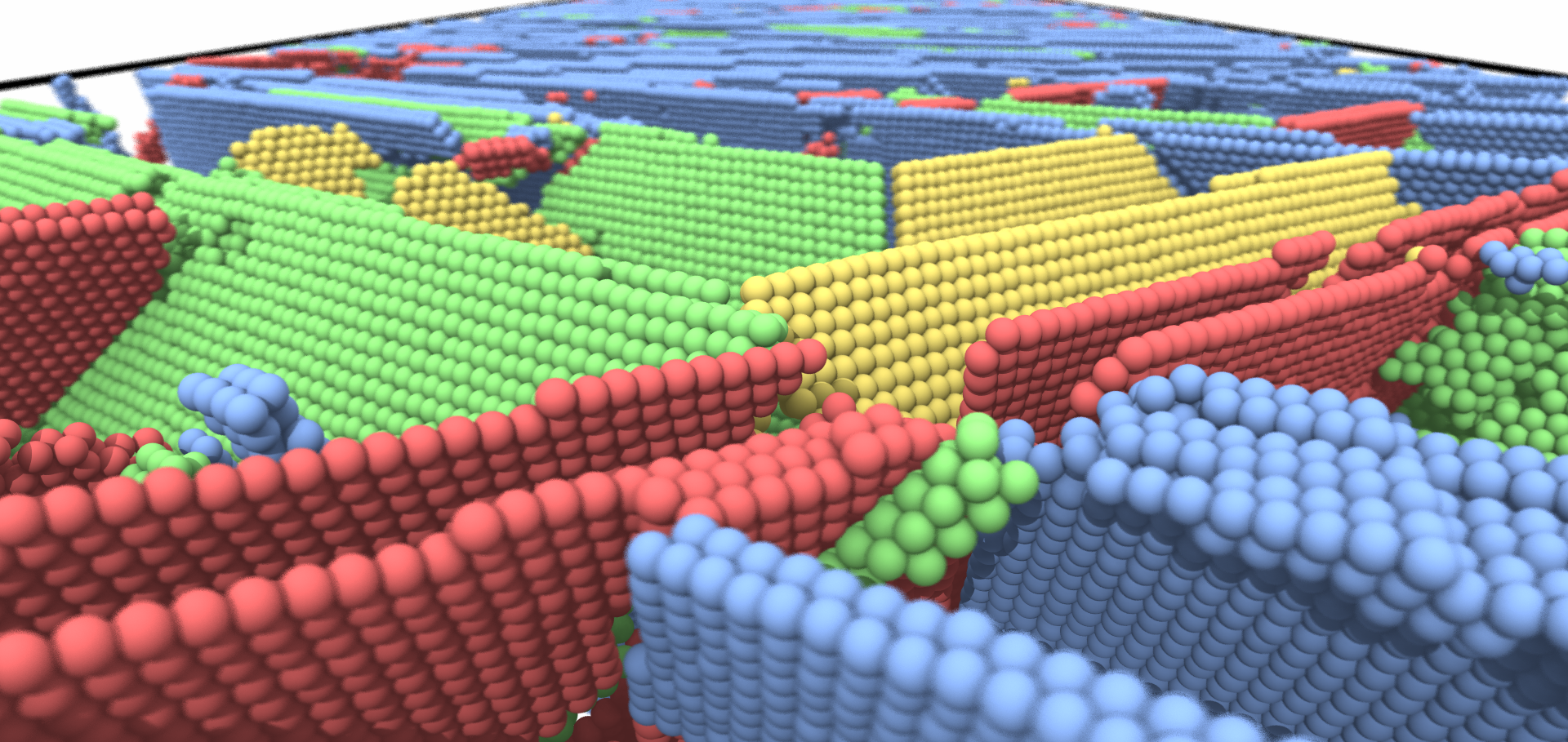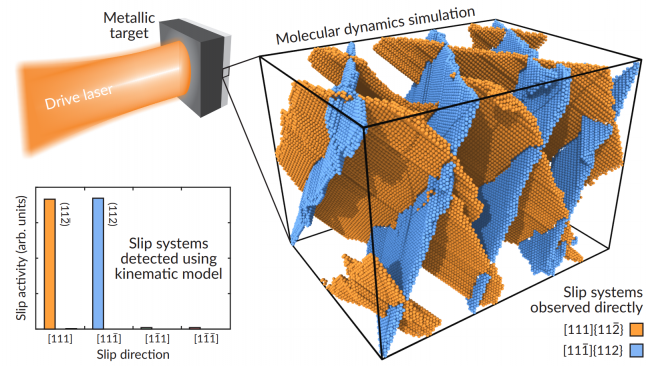Slip competition and rotation suppression in tantalum and copper during dynamic uniaxial compression
Physical Review Materials American Physical Society 6 (2022) 043605
Abstract:
When compressed, a metallic specimen will generally experience changes to its crystallographic texture due to plasticity-induced rotation. Ultrafast x-ray diffraction techniques make it possible to measure rotation of this kind in targets dynamically compressed over nanosecond timescales to the kind of pressures ordinarily encountered in planetary interiors. The axis and the extent of the local rotation can provide hints as to the combination of plasticity mechanisms activated by the rapid uniaxial compression, thus providing valuable information about the underlying dislocation kinetics operative during extreme loading conditions. We present large-scale molecular dynamics simulations of shock-induced lattice rotation in three model crystals whose behavior has previously been characterized in dynamic-compression experiments: tantalum shocked along its [101] direction, and copper shocked along either [001] or [111]. We find that, in all three cases, the texture changes predicted by the simulations are consistent with those measured experimentally using in situ x-ray diffraction. We show that while tantalum loaded along [101] and copper loaded along [001] both show pronounced rotation due to asymmetric multiple slip, the orientation of copper shocked along [111] is predicted to be stabilized by opposing rotations arising from competing, symmetrically equivalent slip systems.Molecular dynamics simulations of inelastic X-Ray scattering from shocked copper
Journal of Applied Physics AIP Publishing 130 (2021) 125901
Abstract:
By taking the spatial and temporal Fourier transforms of the coordinates of the atoms in molecular dynamics simulations conducted using an embedded-atom-method potential, we calculate the inelastic scattering of x-rays from copper singlecrystals shocked along [001] to pressures of up to 70 GPa. Above the Hugoniot elastic limit (HEL), we find that the copious stacking faults generated at the shock front introduce strong quasi-elastic scattering (QES) that competes with the inelastic scattering signal, which remains discernible within the first Brillouin zone; for specific directions in reciprocal space outside the first zone, the QES dominates the inelastic signal overwhelmingly. The synthetic scattering spectra we generate from our Fourier transforms suggest that energy resolutions of order 10 meV would be required to distinguish inelastic from quasi-elastic scattering within the first Brillouin zone of shock-loaded copper. We further note that high-resolution inelastic scattering also affords the possibility of directly measuring particle velocities via the Doppler shift. These simulations are of relevance to future planned inelastic scattering experiments at x-ray Free Electron Laser (FEL) facilities.Crystal plasticity finite element simulation of lattice rotation and x-ray diffraction during laser shock-compression of Tantalum
(2021)
Metastability of diamond ramp-compressed to 2TPa
Nature Nature 589:2021 (2021) 532-535
Abstract:
Carbon is the fourth-most prevalent element in the Universe and essential for all known life. In the elemental form it is found in multiple allotropes, including graphite, diamond and fullerenes, and it has long been predicted that even more structures can exist at pressures greater than those at Earth’s core1,2,3. Several phases have been predicted to exist in the multi-terapascal regime, which is important for accurate modelling of the interiors of carbon-rich exoplanets4,5. By compressing solid carbon to 2 terapascals (20 million atmospheres; more than five times the pressure at Earth’s core) using ramp-shaped laser pulses and simultaneously measuring nanosecond-duration time-resolved X-ray diffraction, we found that solid carbon retains the diamond structure far beyond its regime of predicted stability. The results confirm predictions that the strength of the tetrahedral molecular orbital bonds in diamond persists under enormous pressure, resulting in large energy barriers that hinder conversion to more-stable high-pressure allotropes1,2, just as graphite formation from metastable diamond is kinetically hindered at atmospheric pressure. This work nearly doubles the highest pressure at which X-ray diffraction has been recorded on any material.Investigating off-Hugoniot states using multi-layer ring-up targets
Scientific Reports Springer Nature 10:1 (2020) 13172



